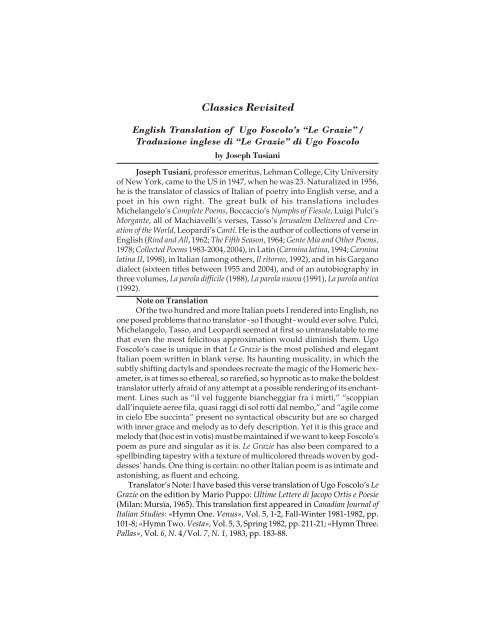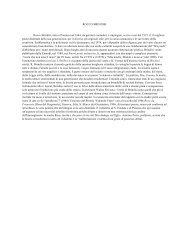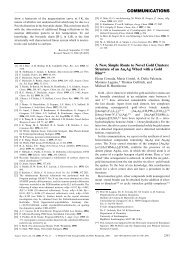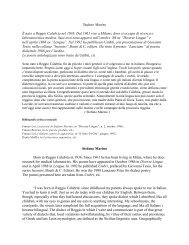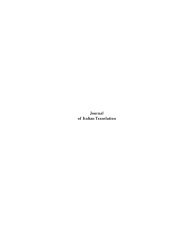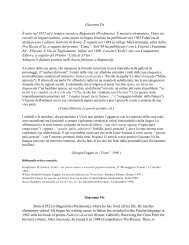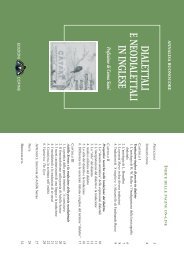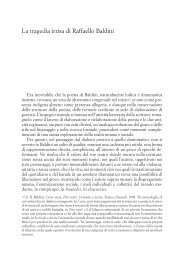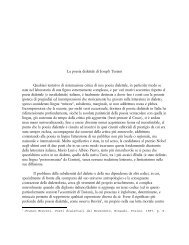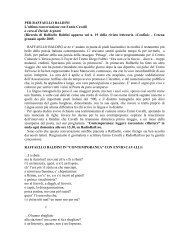Journal of Italian Translation
Journal of Italian Translation
Journal of Italian Translation
You also want an ePaper? Increase the reach of your titles
YUMPU automatically turns print PDFs into web optimized ePapers that Google loves.
Classics Revisited<br />
English <strong>Translation</strong> <strong>of</strong> Ugo Foscolo’s “Le Grazie” /<br />
Traduzione inglese di “Le Grazie” di Ugo Foscolo<br />
by Joseph Tusiani<br />
Joseph Tusiani, pr<strong>of</strong>essor emeritus, Lehman College, City University<br />
<strong>of</strong> New York, came to the US in 1947, when he was 23. Naturalized in 1956,<br />
he is the translator <strong>of</strong> classics <strong>of</strong> <strong>Italian</strong> <strong>of</strong> poetry into English verse, and a<br />
poet in his own right. The great bulk <strong>of</strong> his translations includes<br />
Michelangelo’s Complete Poems, Boccaccio’s Nymphs <strong>of</strong> Fiesole, Luigi Pulci’s<br />
Morgante, all <strong>of</strong> Machiavelli’s verses, Tasso’s Jerusalem Delivered and Creation<br />
<strong>of</strong> the World, Leopardi’s Canti. He is the author <strong>of</strong> collections <strong>of</strong> verse in<br />
English (Rind and All, 1962; The Fifth Season, 1964; Gente Mia and Other Poems,<br />
1978; Collected Poems 1983-2004, 2004), in Latin (Carmina latina, 1994; Carmina<br />
latina II, 1998), in <strong>Italian</strong> (among others, Il ritorno, 1992), and in his Gargano<br />
dialect (sixteen titles between 1955 and 2004), and <strong>of</strong> an autobiography in<br />
three volumes, La parola difficile (1988), La parola nuova (1991), La parola antica<br />
(1992).<br />
Note on <strong>Translation</strong><br />
Of the two hundred and more <strong>Italian</strong> poets I rendered into English, no<br />
one posed problems that no translator - so I thought - would ever solve. Pulci,<br />
Michelangelo, Tasso, and Leopardi seemed at first so untranslatable to me<br />
that even the most felicitous approximation would diminish them. Ugo<br />
Foscolo’s case is unique in that Le Grazie is the most polished and elegant<br />
<strong>Italian</strong> poem written in blank verse. Its haunting musicality, in which the<br />
subtly shifting dactyls and spondees recreate the magic <strong>of</strong> the Homeric hexameter,<br />
is at times so ethereal, so rarefied, so hypnotic as to make the boldest<br />
translator utterly afraid <strong>of</strong> any attempt at a possible rendering <strong>of</strong> its enchantment.<br />
Lines such as “il vel fuggente biancheggiar fra i mirti,” “scoppian<br />
dall’inquiete aeree fila, quasi raggi di sol rotti dal nembo,” and “agile come<br />
in cielo Ebe succinta” present no syntactical obscurity but are so charged<br />
with inner grace and melody as to defy description. Yet it is this grace and<br />
melody that (hoc est in votis) must be maintained if we want to keep Foscolo’s<br />
poem as pure and singular as it is. Le Grazie has also been compared to a<br />
spellbinding tapestry with a texture <strong>of</strong> multicolored threads woven by goddesses’<br />
hands. One thing is certain: no other <strong>Italian</strong> poem is as intimate and<br />
astonishing, as fluent and echoing.<br />
Translator’s Note: I have based this verse translation <strong>of</strong> Ugo Foscolo’s Le<br />
Grazie on the edition by Mario Puppo: Ultime Lettere di Jacopo Ortis e Poesie<br />
(Milan: Mursïa, 1965). This translation first appeared in Canadian <strong>Journal</strong> <strong>of</strong><br />
<strong>Italian</strong> Studies: «Hymn One. Venus», Vol. 5, 1-2, Fall-Winter 1981-1982, pp.<br />
101-8; «Hymn Two. Vesta», Vol. 5, 3, Spring 1982, pp. 211-21; «Hymn Three.<br />
Pallas», Vol. 6, N. 4/Vol. 7, N. 1, 1983, pp. 183-88.


